

|
Back to |
| The Front Page |
| Letters & Opinion |
|
Keith Wylie and Me: A longtime club player explores the usefulness of Keith Wylie's classic tome for the average improving player By Mike Orgill posted March 11, 2015
|
||||||
|
||||||
Keith Wylie's Expert Croquet Tactics will not help you shoot straighter, hit more accurate rushes, or improve your touch in croquet shots. Only practice will improve your technique. But studying this classic work lets you wander around in a brilliant and eccentric croquet mind and might bring a more analytical and creative approach to your play of Association Croquet. You'll have to know a lot more about the game than the "code" used for the balls in the illustrations (U=Blue; R=Red; K=Black; Y=Yellow), but if you have any ambition at all as a competition, it may be worth the struggle. Mike Orgill approaches the book again decades after his first look at it, which he now regards as "naive."
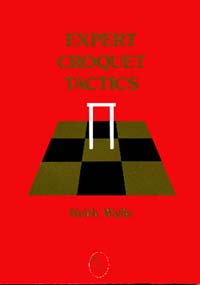
|
What can you do? Had you absorbed Expert Croquet Tactics, Keith Wylie’s masterwork, you would have remembered his advice on http://www.oxfordcroquet.com/coach/ect/article1.asp#z_1_II_8 of the second edition. There he gives a plan in Figure 1.24:
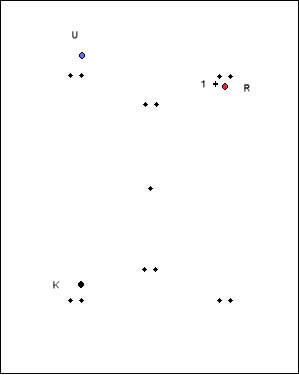
|
| Fig. 1.24 (Y for 1b, croqueting R) |
Even with your nerves and sweaty palms the setup should be doable. As Wylie writes, "[The peel’s] preparation and execution call more for the exercise of judgment than for theoretical technique." And take heart. As the Master opines, "If [the peel] succeeds, but you fail to make 1b, you can win without conceding any more lifts." KW's suggested leave:
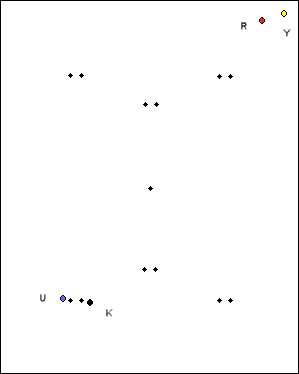
|
| Fig. 2.5 (principal 1b leave) |
And whatever you do, don’t set what KW labels "the standard sextuple leave," [Fig. 2.4] what some call in a non-PC way "the ladies leave". The Celebrated International Star eats this for breakfast.
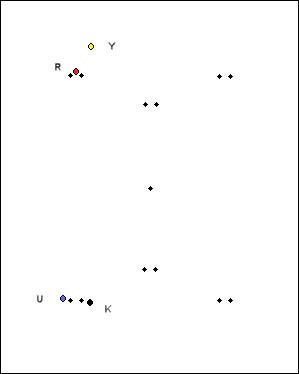
|
| Fig. 2.4 (standard sextuple leave) |
Your best bet is that the Celebrated International Star might miss Fig. 2.5's shot into the third corner. Don’t think about the Tea Lady, whatever you do! And don’t carp that victory might require the completion of a straight double; KW offers pertinent and somewhat original suggestions on how to accomplish that somewhat daunting tactic. Pull up your trousers, you can do it!
Keith Wylie’s Expert Croquet Tactics was first published in 1985, and reissued in a second revised edition in 1991. This edition is now available online in a very useful form on the Oxford Croquet website at http://www.oxfordcroquet.com/coach/ect/. Rather than being an encyclopedic croquet handbook, ECT is actually an anthology of articles dealing with the critical aspects of minus level AC [Association Croquet] play: triple peels, leaves, openings, and break building filtered through a discussion of styles of croquet play. ECT is redolent of Oxbridge atmosphere and holds a unique place in croquet literature, being at once acknowledged as a seminal work by all aspiring and actual croquet experts and at the same time ignored or dismissed as being too arcane.

|
| While officiating at Sonoma-Cutrer, Wylie, in an unceasing quest for perfect exactitude, accidentally drops a straight-edge on a ball while determining whether it is over the string and out of bounds. |
It was a bad idea, given that for me at the time an all-round 4-ball break was a significant achievement. As the master writes, "Articles 1 and 4 and Part II of Article 3 are aimed more at the minus player. Readers who are well below that standard may find the book heavy going." The article I wrote proved that it was "heavy going" for me.
Now, like most normal, mediocre club players I can do an all-around 3- or 4-ball break and I understand and can accomplish some of the maneuvers necessary for a triple peel (although straight triple peels and sextuples are Everests for me). How can ECT be useful for me? Let’s have a glimpse at Wylie’s method.
Let's start with Article 2, which KW implies the non-expert can comprehend. Its subject is leaves. Even though you begin in mediocrity, studying this article might enable you to attain the exalted state of "expert". The article deals with "what one expert (RY) should do when he picks up the first break against another (UK). (Throughout the book KW assumes that RY—with partner balls Red and Yellow--is the in-player.) Can you improve on the simple break to 4b? Keep in mind what KW emphasizes, that "We leave behind the world of everyday croquet, with its missed roquets and blobbed hoops." This is armchair croquet where, seated in leather armchairs at the club, with warm glasses of single-malt in our hands, we discuss what KW calls "whole game tactics".
Do not expect to read ECT as a sustained work of prose. Each small kernel of advice must be mulled over and absorbed. Unless you can easily form eidetic images and hold them before you as you follow KW’s lines of reasoning you should use aids to follow along in the text. I recommend using either a magnetic white board, Danny Huneycutt’s magnetic croquet board, or Ian Plummer’s new internet croquet board app available at the Oxford Croquet website, www.oxfordcroquet.com.
The vast majority of American AC players use only two leaves (in those games, of course, where controlled leaves are set). One is the so-called "diagonal spread":

|
| Fig. 2.3 (R for 4b; Y for 1) |
The other is the so-called "New Standard Leave", Fig. 2.11:

|
| Fig. 2.11 (4b leave; Y for 1) |
Few players deliberately set what KW calls the "Old Standard Leave":
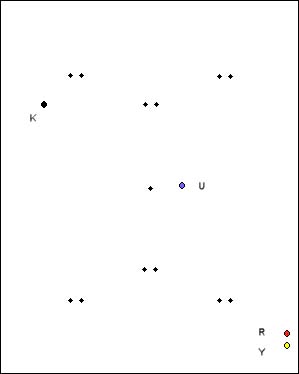
|
| Fig. 2.1 (R for 4b; Y preferably for 2) |
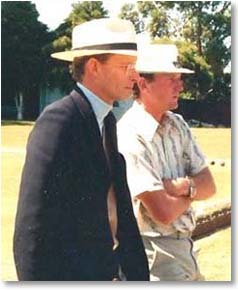
|
| Keith Wylie and Joe Hogan watching the action at Australia's 1982 MacRobertson Shield matches. |
The NSL too has flaws according to KW: "A notable disadvantage is that it often gives clearly better break prospects to UK if he hits R or Y with U than it does to RY if he misses and goes into corner IV." How often have we seen the opponent miss this leave going into the fourth corner and then RY's big stop-shot from IV failing to achieve the rush to one? KW also believes that the leave fails on less than easy courts and that good hitters might find the 18-yard shot easy pickings.
The Old Standard Leave receives unexpected approval from the Master. The OSL has three disadvantages: 1. its 13-yard shot is easily roqueted and compulsory for experts; 2. it gives almost the same favorable break prospects for RY if he hits as it does for UK if RY misses; and 3. if Y has been peeled through hoop one, which is a feature of this tactic, it can easily be peeled through hoop two if UK hits in, spoiling chances for a possible RY triple.
KW reminds us of the ancient days of tournament croquet in England, when the setting of the OSL presented the opponent with a critical problem. Even though the leave might look primitive and easy to hit, Solomon has as a matter of course peeled his partner ball through hoop one, and if you miss the short shot (K at R) Solomon will triple, and if you missed the long shot (K at U from III) he would get a good rush to hoop two. The OSL, featuring the peel of partner through hoop one, is an aggressive and powerful tool in the right hands. It is little used deliberately today and should be reconsidered, but only by players who will complete a triple when the opponent misses.
One-back leaves receive prominent and favorable treatment in this article, something that might surprise knowledgeable readers who have been around American tournaments for the past few decades. You rarely see a one-back leave in serious play unless the player is deliberately setting out to do a sextuple, which KW calls "the Everest" of croquet.
When KW revised ECT in 1991 the croquet world had not seen the sextuple successes of Fulford and some others and viewed the sextuple as generally not worth the risk. However, KW sees more scope for one-back tactics. Again, KW recommends the leave in Fig. 2.5 (see above), what he dubs "an ancient leave" almost universally employed in the days before lifts; indeed this leave created the need for lifts since in those ancient days the first player with a good break could go to the peg and set this leave and almost always win.
KW points out that the one-back leave can also be used to save lifts: "During the second break (with Y) you do not have to press for peels, though you may if you are in the mood. Four peels are usually easy to achieve with safety" [easy for KW to say!] "if UK has shot and missed: 1b after 2; 2b before 4 or 5; 3b straight; and 4b after 4b. However, peels are not essential. You might be disappointed if all you could manage was a straight peel at 1b, but even then 1b tactics would have served their purpose."
Notice the four peels achieved "with safety". This is the essence of "armchair croquet", but KW does have a point. Even with three peels accomplished the opponent (still for one and one) is up against a leave with his opponent for four-back with both balls, and if the leave is precise enough the lift shot will be missed and in a timed game a win may be more probable. But "timed games" are not played in top-level events like the MacRobertson Shield or the Solomon Cup and 1-back tactics are futile against such elite players.
Even against an opponent with balls for one and 4-back KW thought that the 1-back leave has its uses: ". . . consider stopping at 1b and then triple peeling your opponent and doing a double peg-out. By switching pioneers at 3 or around 6 and 1b you can also peel R straight at 1b, with a possible further peel through 2b. The reasoning in favour of this idea is that R, for 2b, ought to win the 2-ball ending against U or K, which is for 1." KW admits that against an expert the 2-ball ending can be unpredictable, and all this strategizing might seem nothing more than the woolgathering of armchair croquet. Other possible tactics he suggests are the NSL or the triple peel of the opponent.
KW believed that the state of our croquet tactics is impoverished and goes on in this article to tackle other more obscure leaves, leaves almost never seen in tournament play. For example, have you ever encountered any of these beauties? A "2-back" leave:

|
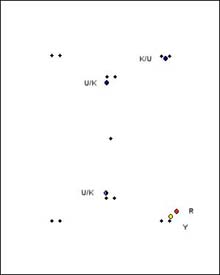
|
| Fig. 2.8 (R for 2b; Y for 2) | Fig. 2.9 (R for 3b; Y for peg) |
"Starting with Y already for 2, preferably, you take R to 2b only and make the leave in Fig. 2.8. Then you take Y to the peg doing a straight peel of R at 2b and make the leave in Fig. 2.9."
(http://www.oxfordcroquet.com/coach/ect/article2.asp#z_2_4)
Or this "defensive 4-back" leave. One often sees a ragged version of this when leaves go out of control, but how often do you see this leave set deliberately?
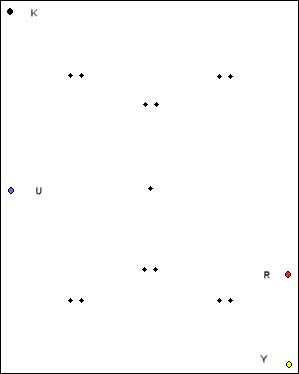
|
| Fig. 2.13 (Y for 1 R for 4b) |
Or this "POP" (peel-on-opponent) leave. (POP tactics are appearing in American tournament play, but only a few elite players employ them at present):
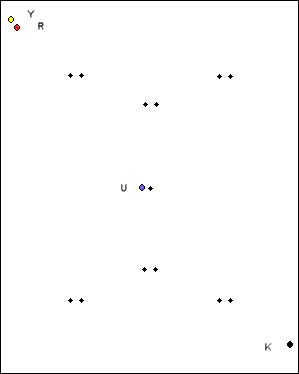
|
| Fig. 2.12 (U for 3) |
The point is not to take KW's leave suggestions as the final word; throughout the book he urges the reader to think for her or himself and model KW's croquet thinking process to come up with new ideas. The world needs new leaves--let's move away from this boring world of endless diagonal spreads and NSL's!
Turning to those sections of ECT that KW himself has written for the expert--Articles 1, 3 and 4--how can the Mediocre Club Player best make use of what seems dauntingly arcane material?
All AC players should aim to acquire the skill to do triple peels reliably and so few do. "The trade-mark of the expert," John Solomon tells us, "and the ambition of most up-and-coming croquet players is the triple peel." But beware, because, as E.P.C. Cotter reminds us, "There is no position too difficult for a triple to be achieved, no position too easy for it to be missed." The Mediocre Club Player might be put off by the density of KW's triple peel article, but if one takes it in very small doses with the help of a magnetic board or some other aid, KW's analytical method will soak into your croquet mind as you carefully follow the Master's intricate steps.
Before going through a few examples first take KW's Quiz. He insists! (http://www.oxfordcroquet.com/coach/ect/article1.asp#z_1_I_1) You may not get the correct answer, but you'll learn something about your own fallibility.
For example, the quiz's first problem:
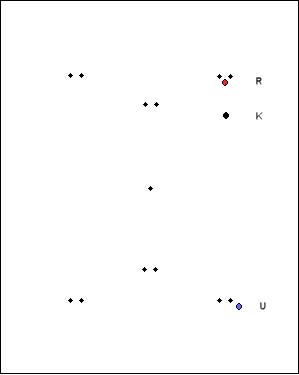
|
| Fig. 1.1 (Y for 3b, croqueting U; R for 4b) |
Problem 1.1: R is for 4b. You are about to approach 3b off U. R has not quite entered the jaws of the hoop.
Look at K and the position of R (your peelee, remember). Your focus is probably on getting the peel immediately after making 3-back. But that would be wrong. After rush peeling R the split shot sending R to penult is awkwardly wide and you would find it difficult to get a rush on K to 4-back. (Work it out on your magnetic board.) Thinking about peeling R with a cannon using U after a precision rush up from 3-back? (Not something most Mediocre Club Players would consider.) Forget about it. R is too far from the jaws. Wiley has the not-so-obvious solution: "Therefore after making 3b you rush U just short of K and cannon it (almost anywhere will do), so that after the rush peel it is easier for you to get behind K." (Once again, a magnetic board will make this clearer.)
Article 1, "The Triple Peel", is the centerpiece of ECT and seemingly incomprehensible for most Mediocre Club Players. It's not enough to be able to do all-around 4-ball breaks (even though the triple is essentially a four-ball break with the pivot as the peelee); then the Mediocre Club Player must become proficient at 3-ball breaks. KW goes further: ". . . before practising triple peels seriously you should first become really adept at the delayed double peel, that is to say the penult peel before 4b and the straight rover peel." Once you've achieved that skill familiarize yourself with the standard moves in the triple peel and settle down for a brain twisting ride through the world of the Wylie triple.
In Article 1, KW assumes that his readers "know the maneuvres of the standard triple and that you appreciate that on an easy court it calls for no more than a few simple strokes played with reasonable accuracy." Be assured that this is largely true, assuming that "simple strokes" are indeed simple for you and your accuracy is indeed accurate. (Remember, we are in the world of armchair croquet. As in battle, all plans are rendered inoperative by their contact with reality.)
Article 1 then covers the intricacies of various stages of the triple peel, i.e., the 4-back peel, the penultimate peel and the rover peel and peg-out. There's too much material here to cover in detail, but here's an example of how KW analyzes a position the player might encounter while doing the triple.
Here is the situation you might find yourself in as you attempt a delayed triple:
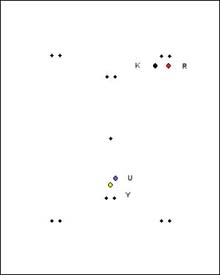
|
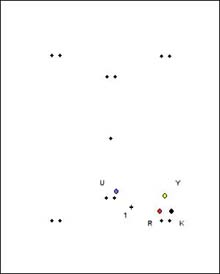
|
| Fig. 1.17 (Y has just run 5) | Fig. 1.18 (Y for 4) |
"Fig. 1.17 shows the ideal position for this peel when you have just run 5. . . . In Fig. 1.18 you have just made 3 and sent U to 5. You have a free choice as to which of R and K to treat as pivot ball and which as pioneer for 4. Use R as the pivot, because then you will position the all-important K from short range and R from about spot (1). . . .I am not fond of peeling 4b just before making 1b. If you feel the same way you, like me, will make a special effort to get a chance to peel before 6. Peeling before 6 has two great advantages over the peel before 1b. First, you can more often do a stop shot peel before 6, which allows you to peel from a greater distance and from more of an angle. Second, you can much more easily afford to jaws the peel before 6. Jawsing before 1b usually leads to a straight double peel finish."
For a special treat, and real glimpse into KW's special approach, read "1.II.10: Peeling 4b after 1b". Most players aren't trying moves like this, but it would send your game up another notch if you could study these moves and incorporate them into your games.
There’s too much in Article 1 to go over in detail here. Not every situation is covered, but studying KW's thinking process and practicing as he recommends will yield many peeling opportunities as your improvise your way through the triple. Don't gloss over "Part VI: Epideixis". "Epideixis" is a term known only to classics majors. It means (per Wikipedia) "[a] rhetoric of ceremony, commemoration, declamation, demonstration, on the one hand, and of play, entertainment, display, including self-display." In KW's hands the display and self-display components are more in evidence. Here he discusses several tricks and fancy strokes designed to get the player out of tight spots during triples. It's worth your attention and is great fun to read.
I've attempted to lead the reader by the hand and show how to approach this knotty book. Don't take ECT as gospel; analyze it, argue with it, come up with your own alternatives. KW is showing you how to think croquet. Too many players, even very expert practitioners, fall into rote, doing the same old breaks and leaves and peeling techniques every time. Don't be that player!
There are other pleasures in ECT. The chapter on the "humours" of croquet sums up KW's view of the four mindsets in croquet and contains KW's theories on break building. Three humours--aggressive croquet, precision croquet, and canny croquet--are the recommended approaches to successful break building. Expert players have different approaches, and KW makes it clear that he does not regard one style as being more correct than another; instead he identifies the three styles as being largely correct and calls out another as being potentially disastrous. For a simple example, take this position:
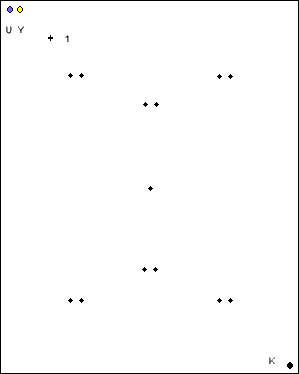
|
| Fig. 3.1 (R for 2, croqueting Y; U, K, Y for 1) |
The aggressive player (playing R) stop-shots Y to spot (1) and takes position at hoop 2 with a split shot sending U to pioneer position at hoop 3. One big stroke and the break begins.
The precision player takes off to a rush behind U, makes hoop 2, rushes U back to corner II, stop-shots it out 3 yards, rushes Y accurately to 3, and then rushes Y to corner II, hoop 4 or corner IV. A little more work, but if you have the touch, why not?
The canny player, not trusting his chances of building a break from this position, rushes U into the court, takes off to K, putting it on the court, and retires back to corner II with this position:
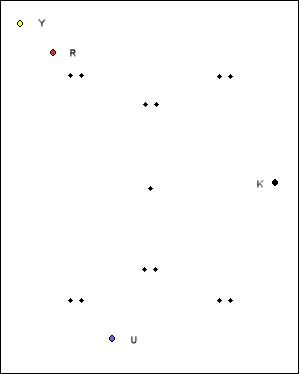
|
| Fig. 3.2 ("Canny croquet" sequel to Fig. 3.1) |
But the "Monte Carlo" player will have none of this. To quote KW:
Now it is not you playing R, but Our Friend. He takes off to U, rushes it a little to the West of 2, stop-shots it 7 yards or so towards 3, runs 2 and shoots at Y. "All I have to do is hit a 5-yard shot and I have a break." Our Friend fails to see (a) that if he does not get position at 2 he has nowhere good to go with R; (b) that if he runs 2 and misses Y he leaves U a perfectly plausible 14-yard shot at what may well be a double target; and (c) that even if he hits Y he is going to be walking on egg shells while trying to make 3 with his "break". In short, he is putting the innings at risk at inadequate odds. "Never mind the odds. This is how I like to play. Why don’t you go and watch some other match?"
How often, on a beautiful spring days at Sonoma-Cutrer, have I seen plays like this! In fact, I see the Monte Carlo style exhibited in tournaments and friendly play as often as I see aggressive, precision or canny play. On America's easy courts it's often successful. After all, "he's going round anyway" is usually the excuse for risky behavior, and many times the gamble pays off. If Monte Carlo is not your cup of tea, canny play is often the fall-back position, but again, on easy courts your leave is roqueted more often than not.
Other examples of the "humours" in this chapter are analyzed and deserve careful study. If you have been playing seriously for a few years, reading Article 3 may make you think that you know all of this already. Writes KW:
"Well, so did I after only a few years in the game, but it was disorderly knowledge. I failed to appreciate the value of a balanced style and made no effort to remove weaknesses from my game. I am pretty sure that my own lack of insight was typical of most croquet players. We get set in our ways, preferring the strokes we do best and letting our less good strokes atrophy."
And KW make it clear which "humour" he prefers:
"I am an unashamed fan of precision croquet--Shakespeare to aggressive croquet’s slapstick. The dramatic climax of aggressive croquet is somewhat obvious, the peripeteia contrived, and when the crisis has passed it is too often followed by the bathos of a simple-minded break. There is nothing to rival the gradual build-up of a precision break, particularly when you can look forward to a little thought being given to the leave."
But we all love the aggressive or Monte Carlo approach, don't we? The momentary rush of excitement followed by the boring old break. But can we not use KW to forge a more elegant croquet instrument?
Article 3 also contains some useful technical hints. You may think you know it all, but see if you use this decades-old advice to improve your game. As KW in the epigram to ECT quotes Cassandra from Aeschylus's Agamemnon: "I shall no longer teach in riddles." Again, to profit from Expert Croquet Tactics take the text in small doses and keep an open mind.
Stuart Lawrence and Ian Plummer have done an admirable job of converting Expert Croquet Tactics into an easily accessible online form. Perhaps now this seminal masterpiece will get the attention and influence it deserves. And perhaps, influenced and inspired by this work, future croquet geeks will upstage the master with an even more brilliant and groundbreaking work of croquet philosophy.
Finally, as KW does, I give the last word to Erasmus:
"The ones who write learnedly for the verdict of a few scholars ... seem to me more pitiable than happy, since they continually torture themselves: they add, they alter, they blot something out, they put it back in, they do their work over, they recast it, they show it to friends, they keep it for nine years; yet they never satisfy themselves ... The scholar considers himself compensated ... when he wins the approbation of one or two other weak-eyed scholars."
Lawn diagrams Copyright 2014 Dr. Ian Plummer. The Oxford Croquet Site is independent and is not associated with any company, the Croquet Association, Oxford University or any other bodies. It is entirely owned and maintained by Dr. Ian Plummer.
Mike Orgill is the president of the Sonoma Croquet Club, chair of the USCA International Committee, and a member of the WCF management committee. Like many decently ranked American rules players, this famously modest man says he is "still learning how to play Association Croquet." Orgill is responsible for the entire croquet career of the publisher of CROQUET WORLD ONLINE at a time when we met while working on the same writing projects in San Francisco. He insisted that we join the USCA in the early eighties, overcoming my objection that "it looks too serious." We re-organized the San Francisco Croquet Club and managed together the beginnings of the San Francisco Open before it became the most challenging event in the annual USCA calendar in an era when most of the top American players lived in or near San Francisco and played at the SFCC. We competed often in singles and actually cooperated in doubles tournaments as well as a brief magazine publishing adventure with Hans Peterson we called CROQUET MAGAZINE. Neither of us could understand why croquet was such a small fringe sport. We still can't understand that. Mike Orgill is a fine writer and a very kind man who graciously agreed to share his second look at the Wylie classic.